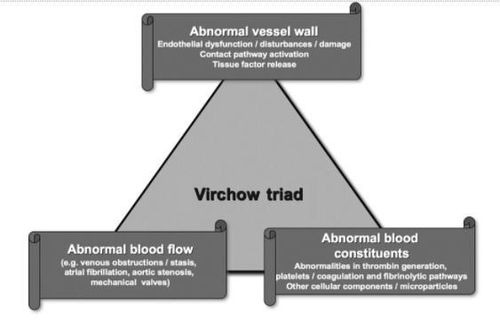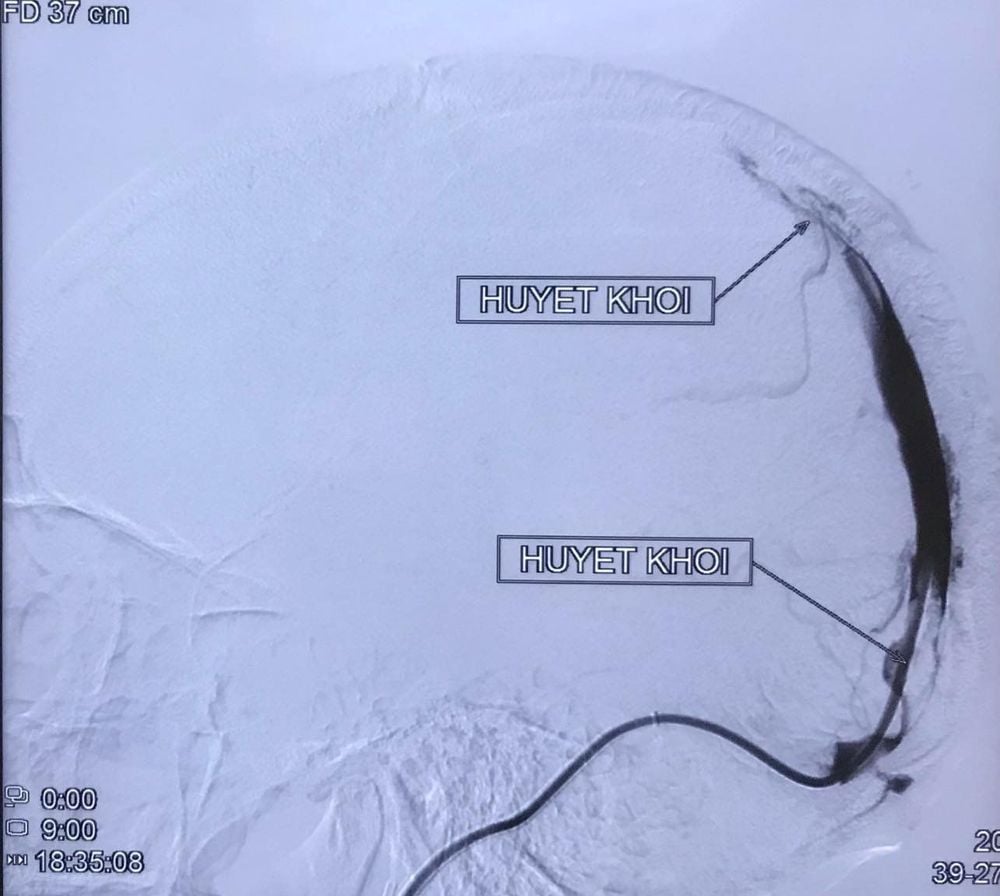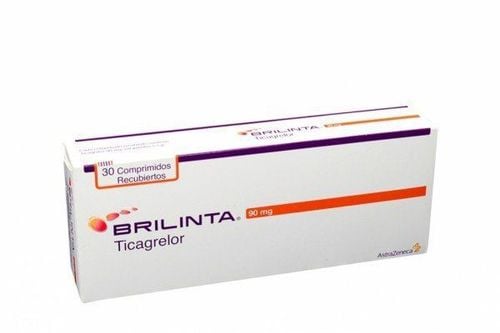This is an automatically translated article.
Posted by Specialist Doctor II Pham Tien Ngoc - Emergency Resuscitation Department - Vinmec Central Park International General Hospital
Cerebral venous thrombosis is a general term describing thrombosis of the cerebral venous system, including: dural sinus thrombosis, deep venous thrombosis (deep venous thrombosis) ) and cortical venous thrombosis.
1. Epidemiological factors
Unlike other cerebrovascular diseases, cerebral venous thrombosis often occurs in children and adolescents. According to statistics, there are about 7 cases / 1 million children and newborns with cerebral venous thrombosis, with the rate of 3-4 cases / 1 million people.
2. Causes of cerebral venous thrombosis
Causes of cerebral venous thrombosis can be bacterial and non-infectious:
Infection: Infection of the head, face, neck, eye sockets, otitis media, meningitis and sepsis,... Non-infectious: The most common are cancer, traumatic brain injury, cavernous carotid artery bypass, oral contraceptives, blood clotting disorders, collagen disease, polycythemia vera, postpartum, nephrotic syndrome, .. About 20-35% of cerebral venous thrombosis of unknown cause
3. Pathogenesis of cerebral venous thrombosis
Cerebral venous thrombosis is due to complete or partial occlusion of one or more sinuses or cortical veins, resulting in vascular stasis and focal/ diffuse neurological damage. The presentation of nerve damage depends on the location of the obstruction. If a large sinus is occluded, it will lead to increased intracranial pressure, deep cerebral venous occlusion can cause local edema, infarction, and small hemorrhages, which may later merge into major bleeding.
Most cases of deep cerebral vein obstruction are related to the dural venous sinuses. The formation of thrombus in the venous system draining the brain is the result of the risk factors mentioned in the Virchow triad hypothesis (according to the Rudolf Virchow hypothesis, there are 3 basic factors for the formation of thrombus). Venous Thrombosis: It is venous stasis, hypercoagulability, and damage to the vessel wall. Most of the major factors that cause thrombosis are stasis and hypercoagulability).

Cơ chế bệnh sinh của huyết khối tĩnh mạch não
4. Symptoms of cerebral venous thrombosis
Symptoms of cerebral venous thrombosis are diverse, depending on the location of the blockage. Onset is usually subacute (from 2 to 30 days) but can also be sudden and acute (less than 2 days). Presents like a stroke (20-30% of cases) or a brain tumor.
The clinical symptoms of cerebral venous thrombosis are headache, papilledema, convulsions, focal neurological damage such as motor paralysis, sensory disturbances, impaired consciousness and language disturbances.
Symptoms of cerebral venous thrombosis may be independent or combined, such as: Increased intracranial pressure with headache and papilledema; Headache associated with focal neurological deficits and convulsions; Cranial nerve paralysis with headache; Atypical subacute brain injury; Cavernous sinus syndrome with conjunctival edema; Eyeball protrusion and pain in the eye area.
Headaches have many causes, in cerebral venous thrombosis, headache is the most frequent and earliest symptom. This is also the main reason for patients with cerebral venous thrombosis to be hospitalized. Papillary edema with cerebral venous thrombosis ranges from 45%-86%. However, this sign is rarely seen in cases of acute progression. Patients with cerebral venous thrombosis may be affected by visual acuity or visual field, possibly by damage to the visual cortex, the optic ray, or by increased intracranial pressure leading to papilledema. Convulsions may be the primary symptom of cerebral venous thrombosis, with rates ranging from 10% to 60% of cases. Seizures are common in children 58% and neonates 78%. Movement abnormalities are usually progressive limb weakness with a predominance of bipedal weakness. If the onset is sudden, cerebral venous thrombosis can easily be confused with a stroke caused by damage to the arteries. The chronic onset resembles a brain tumor while the subacute case resembles a brain abscess. Consciousness disturbances: Common in cerebral venous thrombosis, varying degrees of severity, leading to coma. Impaired consciousness alone is easily misdiagnosed with encephalitis, disseminated endovascular sclerosis, metabolic disturbances, and cerebral vasculitis. Cranial nerve palsy accounts for 12% of cases of cerebral venous thrombosis. The most common cranial nerves are the III, IV, V, VI, VII, VIII, IX, X and XI nerves. These cranial nerves may be involved alone or in combination with multiple cranial nerves. Visual disturbances: In patients with lateral sinus thrombosis, diplopia will appear due to damage to the VI nerve and irritation of the V nerve with pain in the temporal and posterior orbits. This is a common symptom in Gradenigo syndrome, which also suggests damage to the parietal petrous nerves.
5. Clinical characteristics of some common venous thromboembolism sites
Clinical features of some common sites of cerebral venous thrombosis include:
Superior longitudinal vein thrombosis: Most common, patients have focal or generalized seizures, paralysis of one leg and then spread to the other leg, impaired consciousness, possible meningeal syndrome, raised intracranial pressure syndrome, papilledema, papilledema, and infection syndrome. Venous thrombosis of the lateral sinus: Patients with headache mainly on the ear pain side, dizziness, vomiting, nausea, facial pain, papilledema, infection syndrome, meningoencephalitis, lateral jugular vein distension. stretch. Thrombophlebitis of cavernous sinus: orbital pain, papilledema, protrusion, conjunctival protrusion, periorbital hemorrhage, paralysis of common oculomotor nerve causing drooping eyelids, strabismus, diplopia, infection syndrome, It can be one eye or both eyes. Cerebral venous thrombosis: There are often partial seizures, altered consciousness, raised intracranial pressure syndrome, hemiplegia, and speech disturbances. Transverse sinus thrombosis: Ear pain, ear discharge, pain and swelling of lymph nodes in the neck of the neck on the same side, neck stiffness. The cause is usually otitis media, mastoid otitis.

Hình ảnh huyết khối tĩnh mạch não
In summary, cerebral venous thrombosis is a dangerous disease that can affect the patient's life if not treated promptly. Therefore, to protect health and prevent complications of cerebral venous thrombosis, patients need to go to the hospital to be examined by a neurologist as soon as they have symptoms.
Currently, Vinmec International General Hospital is one of the most prestigious medical treatment units for neurological diseases in Vietnam. The Department of Neurology at Vinmec has the function of examining, diagnosing, consulting and treating diseases related to neurological factors, including headaches, vestibular syndrome, cerebellar syndrome, dementia The typical method of the department is to use intravenous and arterial fibrinolytic drugs for stroke cases, along with the combination with paraclinical means such as electroencephalography, electromyography. ST Scan, MRI,...
Neurological examination at Vinmec, customers will be:
Examination by a team of highly qualified and experienced experts such as: Doctor Nguyen Thi Minh Phuong , Doctor Bui Ngoc Phuong Hoa, Doctor Vu Duy Dung ... State-of-the-art equipment, comparable to major hospitals in the world: The most modern silent magnetic resonance imaging machine in Southeast Asia; The 16-sequence PET/CT and SPECT/CT systems help in early detection of neurological damage even when there are no symptoms of the disease. Apply the most advanced intensive treatment techniques in the world in treatment.
Please dial HOTLINE for more information or register for an appointment HERE. Download MyVinmec app to make appointments faster and to manage your bookings easily.













